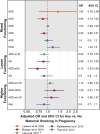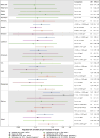Environmental chemical exposures and autism spectrum disorders: a review of the epidemiological evidence
- PMID: 25199954
- PMCID: PMC4855851
- DOI: 10.1016/j.cppeds.2014.06.001
Environmental chemical exposures and autism spectrum disorders: a review of the epidemiological evidence
Abstract
In the past decade, the number of epidemiological publications addressing environmental chemical exposures and autism has grown tremendously. These studies are important because it is now understood that environmental factors play a larger role in causing autism than previously thought and because they address modifiable risk factors that may open up avenues for the primary prevention of the disability associated with autism. In this review, we covered studies of autism and estimates of exposure to tobacco, air pollutants, volatile organic compounds and solvents, metals (from air, occupation, diet, dental amalgams, and thimerosal-containing vaccines), pesticides, and organic endocrine-disrupting compounds such as flame retardants, non-stick chemicals, phthalates, and bisphenol A. We included studies that had individual-level data on autism, exposure measures pertaining to pregnancy or the 1st year of life, valid comparison groups, control for confounders, and adequate sample sizes. Despite the inherent error in the measurement of many of these environmental exposures, which is likely to attenuate observed associations, some environmental exposures showed associations with autism, especially traffic-related air pollutants, some metals, and several pesticides, with suggestive trends for some volatile organic compounds (e.g., methylene chloride, trichloroethylene, and styrene) and phthalates. Whether any of these play a causal role requires further study. Given the limited scope of these publications, other environmental chemicals cannot be ruled out, but have not yet been adequately studied. Future research that addresses these and additional environmental chemicals, including their most common routes of exposures, with accurate exposure measurement pertaining to several developmental windows, is essential to guide efforts for the prevention of the neurodevelopmental damage that manifests in autism symptoms.
Copyright © 2014 Mosby, Inc. All rights reserved.
Figures








References
-
- Developmental Disabilities Monitoring Network Surveillance Year 2010 Principal Investigators. Prevalence of autism spectrum disorder among children aged 8 years—autism and developmental disabilities monitoring network, 11 sites, United States, 2010. MMWR Surveill Summ. 2014;63(suppl 2):1–21. - PubMed
-
- Manning-Courtney P, Murray D, Currans K, et al. Autism spectrum disorders. Curr Probl Pediatr Adolesc Health Care. 2013;43(1):2–11. http://dx.doi.org/10.1016/j.cppeds.2012.08.001. - DOI - PubMed
-
- Coury DL, Swedo SE, Thurm AE, et al. Treating the whole person with autism: the proceedings of the Autism Speaks National Autism Conference. Curr Probl Pediatr Adolesc Health Care. 2014;44(2):26–47. http://dx.doi.org/10.1016/j.cppeds.2013.12.002. - DOI - PubMed
-
- Engel SM, Daniels JL. On the complex relationship between genes and environment in the etiology of autism. Epidemiology. 2011;22(4):486–8. http://dx.doi.org/10.1097/EDE.0b013e31821daf1c. - DOI - PubMed
-
- Landrigan PJ. What causes autism? Exploring the environmental contribution. Curr Opin Pediatr. 2010;22(2):219–25. http://dx.doi.org/10.1097/MOP.0b013e328336eb9a. - DOI - PubMed
Publication types
MeSH terms
Substances
Grants and funding
LinkOut - more resources
Full Text Sources
Other Literature Sources
Medical
Miscellaneous

